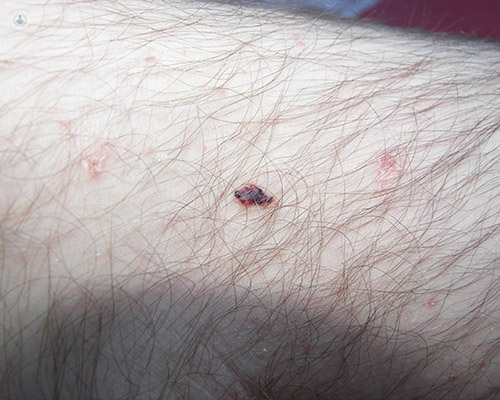

What are angiomas?
Angiomas are tumours which are non-cancerous (benign), made up of small blood vessels. They appear on the surface of the skin and can be located on any part of the body. There are different types of angioma including cherry angioma, spider angioma, and angiokeratomas. These tumours are harmless but patients may wish to have them removed for aesthetic reasons.

What are the symptoms of angioma?
Angioma can occur on any part of the body, and they look different depending on the type.
Cherry angioma:
- Usually purple, blue, black, or red coloured
- Are on top of the skin as a growth
- Come in single form or in clusters
- Can grow to ¼ of an inch in size
- If struck, they bleed considerably
Spider angioma:
- Are more common in childhood and pregnancy
- Can be frequently food on the neck, face, arms, fingers, and back of hands
- Are below the surface of the skin and have a single red spot with extensions coming from it (thus the name ‘spider angioma’)
Angiokeratoma
- Creates small marks on the skin which are red and blue
- Often look like warts
- Feel hard and do not fade when compressed
What causes angiomas?
The exact cause is unknown, but certain people may be more likely to get them because of genetic disposition. They are often connected with age, and they are also linked to chemical exposure, particular medical conditions, and some arise in pregnancy.
Cherry angiomas are associated with ageing, and seem to appear more in individuals over 30, becoming more common in older age.
How are angiomas treated?
Because angiomas are benign, treatment isn’t particularly necessary, but some people do choose to have angiomas removed for cosmetic reasons. If the angioma is in a position which causes it to bleed frequently because it is knocked, this means it may need to be removed.
There are several treatment options for angiomas, including freezing the lesion, burning the angioma, having laser surgery performed, or having the angioma removed through excision. In some cases surgery may be an option to cut out the angioma. Depending on the size of the angioma you may need more than one treatment session. Surgery or treatment can leave behind bruising or scarring, but this clears up after a while.
How can angiomas be prevented?
The cause of angiomas is not known, so prevention is not really considered. Angiomas are also not cancerous, so they are nothing to worry about if you do develop one. You may decide to have them removed, but this is easily achieved and a dermatologist or expert in aesthetic medicine can easily advise the best course of treatment.
